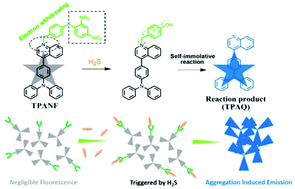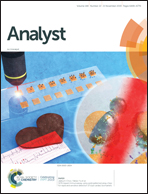A fluorescent probe based on aggregation-induced emission for hydrogen sulfide-specific assaying in food and biological systems†
Abstract
A fluorescent probe based on a triphenylamine benzopyridine platform for hydrogen sulfide (H2S) assaying has been designed and synthesized. As a result of the H2S-triggered cleavage reaction, the disappearance of the quenching effect of dinitrophenyl and the increased hydrophobicity in a poor solvent lead to the aggregation-induced emission (AIE) effect; consequently an obvious ‘turn-on’ fluorescence signal can be observed in this process. The probe TPANF features high selectivity towards H2S, low detection limit (0.17 μM), and good photostability and biocompatibility. Moreover, it has been successfully utilized to monitor H2S in food samples to distinguish the extent of food deterioration and to identify the H2S concentration variation in living cells. In addition, endogenous H2S in HCT-116 xenograft tumor tissues was imaged by using this probe. The approach could provide useful insight for the development of other activatable AIE-based probes that are potentially helpful for specific assaying in food chemistry and biological systems.



 Please wait while we load your content...
Please wait while we load your content...